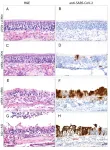(Press-News.org) New Haven, Conn. — Each person has about 4 million sequence differences in their genome relative to the reference human genome. These differences are known as variants. A central goal in precision medicine is understanding which of these variants contribute to disease in a particular patient. Therefore, much of the human genome annotation effort is devoted to developing resources to help interpret the relative contribution of human variants to different observable phenotypes – i.e., determining variant impact.
Recently, Yale School of Medicine led a large NIH-sponsored study where multiple institutions and international collaborators came together to address this challenge. This study generated a large, organized dataset from four individual donors using high-quality genome sequencing to identify all the variants and many different assays to determine their effect on molecular phenotypes in 25 different tissues. Known as EN-TEx, the resource is an important step toward the future of personalized care. The team published its findings in Cell on March 30.
“Our work helps provide a better annotation of the genome and a better understanding of variant impact,” says Mark Gerstein, PhD, Albert Williams Professor of Biomedical Informatics and member of the new Yale Section of Biomedical Informatics & Data Science. He also is affiliated at Yale with molecular biophysics & biochemistry, computer science, and statistics & data science. “An average person’s personal genome has variants in 4 million places. We’re trying to figure out which of these lead to meaningful differences.”
"This work represents the type of innovative large-scale data mining and teamwork that Yale is well-poised to create, coordinate, or participate in,” says Lucila Ohno-Machado, MD, MBA, PhD, Waldemar von Zedtwitz Professor of Medicine and of Biomedical Informatics & Data Science, and chair of the new section. “As our new academic unit grows, we expect to see more and more of this type of exemplary biomedical data science work originate from here.”
In their latest project, the team utilized long-read sequencing technologies to determine diploid genomes from four donors with high accuracy. Everyone has a diploid genome. This means that we have two copies of 22 chromosomes as well as sex chromosomes—one from our mother and one from our father. “Now, for each position on the genome, we can look for the differences between mom and dad in many different functional assays in a perfectly balanced way, allowing us to accurately ascertain variant effect in many tissues,” says Gerstein.
The team developed a variety of statistical and deep learning approaches to be able to leverage the dataset for practical applications. In particular, they built statistical models that identify subsets of regulatory regions in the human genome highly associated with disease variants. They also found many new linkages between variants and changes in nearby gene expression, connecting impactful but uncharacterized variants to genes with known function. This considerably expands previously determined catalogs, especially in many hard-to-assay tissues.
More fundamentally, the team developed a deep learning model that was able to predict whether a variant would disrupt a binding site for a regulatory factor—a protein that binds to specific sequences in the genome to turn nearby genes on or off. Interestingly, they found that to accurately predict this, they needed to look beyond just the binding site itself and consider a large genomic region around the site. The key to whether a binding site would be impacted was the presence of nearby binding sequences for other regulatory factors. “Think of regulatory factors as the legs of the Lunar Module,” says Gerstein. “If it has four legs and one leg doesn’t work, the three other legs can anchor the defective leg.” Similarly, the anchoring of other regulatory factors might stabilize the disrupted binding site and make it less sensitive to variants.
One limitation of the resource is that only four people of European descent are profiled. The team would like to eventually enlarge their study to encompass hundreds of individuals with more diverse ancestries.
Overall, these advances will allow researchers and clinicians to better interpret potential disease-causing variants in an individual, connecting them to regulatory sites, nearby genes, and their tissue of action. “We’ve provided a consistent, beautiful data set and annotation resource for making these interpretations,” says Gerstein.
The global team was assembled by the National Human Genome Research Institute (NHGRI) within NIH, as part of NHGRI's ENCODE consortium, which aims to functionally annotate the genome. The team included collaborators from institutions including Baylor College of Medicine; the Broad Institute of MIT and Harvard; California Institute of Technology; the Centre for Genomic Regulation; Cold Spring Harbor Laboratory; the Dana-Farber Cancer Institute; the European Bioinformatics Institute; HudsonAlpha Institute for Biotechnology; Johns Hopkins University; New York Institute of Technology; Stanford University; University of California, Irvine; University of California, San Diego; University of Hong Kong; University of Massachusetts Medical School; University of Toronto (Canada); and University of Washington, Seattle.
END
Yale-led team creates comprehensive resource for impact of genomic variants
2023-04-03
ELSE PRESS RELEASES FROM THIS DATE:
Illegal trade and poor regulation threaten pangolins in China
2023-04-03
Pangolins, unique scale-covered mammals, are drastically declining in numbers across Asia and Africa, largely due to illegal trade. Part of the trade, both legal and illegal, supports the traditional Chinese medicine market, which has attracted conservation attention. The level of demand for pangolins and other animals in traditional Chinese medicine, however, hasn’t been thoroughly studied.
In a new study published in the journal Nature Conservation, Dr Yifu Wang, currently a postdoc researcher at the University ...
DELLA proteins could hold key to the next Green Revolution
2023-04-03
A family of ‘promiscuous’ proteins found in all land plants is responsible for many different plant functions, despite remaining relatively unchanged for over 450 million years.
New findings, published in Nature Plants and New Phytologist reveal new knowledge about how DELLA proteins regulate how much a plant grows, when germination occurs and how plants deals with threats such as drought and disease. The key is not in DELLA proteins’ ability to mutate over time, but instead in their ability to interact with dozens of different transcription factors, the proteins responsible for decoding DNA.
Understanding the mechanisms which underpin ...
Rising temperatures alter ‘missing link’ of microbial processes, putting northern peatlands at risk
2023-04-03
If you’re an avid gardener, you may have considered peat moss — decomposed Sphagnum moss that helps retain moisture in soil — to enhance your home soil mixture. And while the potting medium can help plants thrive, it’s also a key component of peatlands: wetlands characterized by a thick layer of water-saturated, carbon-rich peat beneath living Sphagnum moss, trees, and other plant life.
These ecosystems cover just 3% of Earth’s land area, but “peatlands store over one-third of all soil carbon on the planet,” explains Joel Kostka, professor and associate chair of Research in the School of Biological ...
Maclean studying paid sick leave mandates & mental health care service use
2023-04-03
Catherine Maclean, Associate Professor, Schar School of Policy and Government, received $641,155 from the National Institutes of Health for: "Paid Sick Leave Mandates and Mental Healthcare Service Use."
This project will provide the first causal estimates of the effect of state and local paid sick leave (PSL) mandates on access to PSL among those with mental health disorder(s), use of mental health care, and indicators of potential quality of mental health care received. It will also examine how community-level factors (e.g., mental health ...
How two different types of immune cells help two billion people keep tuberculosis in check
2023-04-03
More than 10 million people are sickened by tuberculosis (TB) globally each year, resulting in 1.5 million deaths. Yet, as many as two billion people are infected with Mycobaterium tuberculosis, the bacterium that causes tuberculosis, and are otherwise healthy and asymptomatic. Scientists who study TB look at those individuals who can tolerate and contain the infection in hopes of developing better treatments and vaccines.
The key feature of tuberculosis infection in humans is the formation of granulomas, or clusters of immune cells in the lungs that contain the infection. These granulomas contain B cells, all-purpose immune cells that perform a variety of functions, from producing ...
Do Earth-like exoplanets have magnetic fields? Far-off radio signal is promising sign
2023-04-03
Earth's magnetic field does more than keep everyone's compass needles pointed in the same direction. It also helps preserve Earth’s sliver of life-sustaining atmosphere by deflecting high energy particles and plasma regularly blasted out of the sun. Researchers have now identified a prospective Earth-sized planet in another solar system as a prime candidate for also having a magnetic field — YZ Ceti b, a rocky planet orbiting a star about 12 light-years away from Earth.
Researchers Sebastian Pineda and Jackie Villadsen observed a repeating radio signal emanating from the star YZ Ceti using the Karl G. Jansky Very Large Array, a radio telescope ...
Higher lithium levels in drinking water may raise autism risk
2023-04-03
Pregnant women whose household tap water had higher levels of lithium had a moderately higher risk of their offspring being diagnosed with autism spectrum disorder, according to a new study led by a UCLA Health researcher.
The study, published April 3 in JAMA Pediatrics, is believed to be the first to identify naturally occurring lithium in drinking water as a possible environmental risk factor for autism.
“Any drinking water contaminants that may affect the developing human brain deserve intense scrutiny,” said lead study author Beate Ritz, MD, PhD, professor of neurology in the David Geffen School of Medicine at UCLA ...
Nasal vaccine to prevent COVID-19 passes first tests
2023-04-03
Since the beginning of the COVID-19 pandemic, researchers have been working on mucosal vaccines that can be administered through the nose. Now, scientists in Berlin have developed a live attenuated vaccine for the nose. In “Nature Microbiology”, they describe the special immune protection it induces.
Joint press release by Freie Universität Berlin, Max Delbrück Center and Charité – Universitätsmedizin Berlin
Coronaviruses spread primarily through the air. When infected people speak, cough, sneeze or laugh, they expel droplets of saliva containing the virus. Other people then breathe ...
Research finds global emissions of several banned ozone-destroying chemicals are increasing
2023-04-03
The research, published today in Nature Geoscience and led by the University of Bristol and National Oceanic and Atmospheric Administration (NOAA), puts the rise in part down to the chemicals, known as chlorofluorocarbons or CFCs, being used to make other ozone-friendly alternatives to CFCs. This is an exception allowed under the Montreal Protocol, but contrary to its wider goals.
Lead author Dr Luke Western, a Research Fellow at the University of Bristol and researcher at the NOAA’s Global Monitoring Laboratory (GML), said: “We’re paying attention to these emissions now because of the success of the Montreal Protocol. CFC ...
Early menopause, later start to hormone therapy may increase risk of Alzheimer’s disease
2023-04-03
BOSTON — Women are more likely than men to develop Alzheimer’s disease (AD), with women making up two-thirds of the population living with AD. A new study, led by Mass General Brigham researchers, sheds light on the relationship between the risk of Alzheimer’s disease and age of menopause and use of hormone therapy (HT). The results, published in JAMA Neurology, indicate that early age at menopause may be a risk factor for AD dementia, but that women who were prescribed HT around the age of menopause onset did not show increased risk.
“HT is the most reliable way to ameliorate severe menopause symptoms, ...




